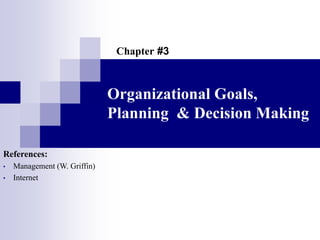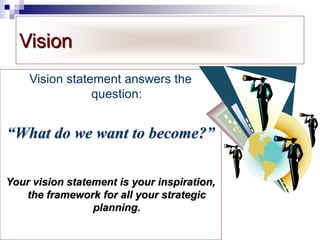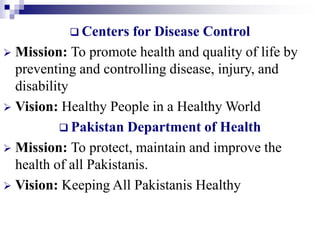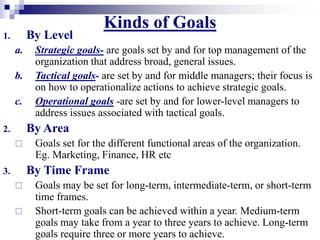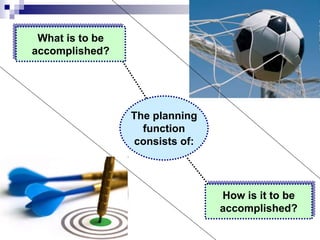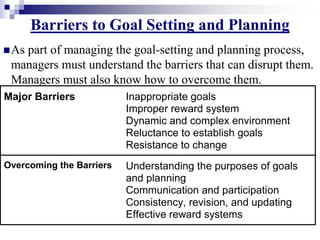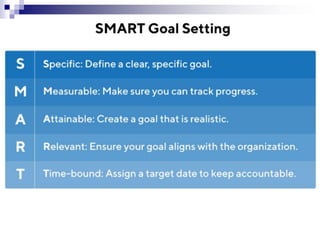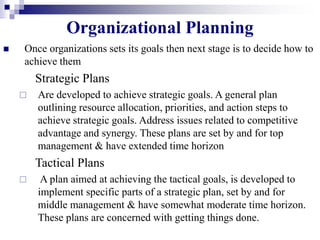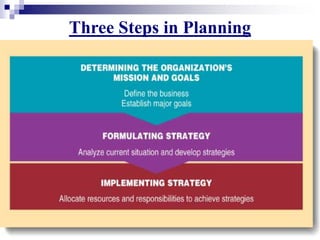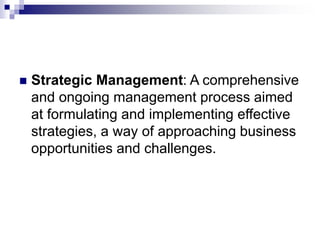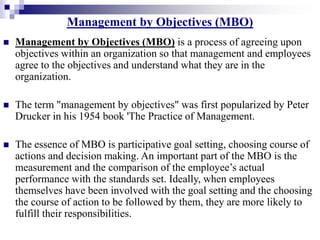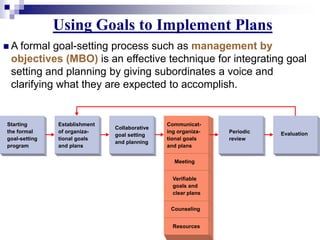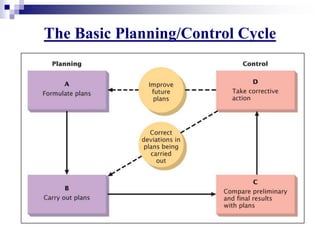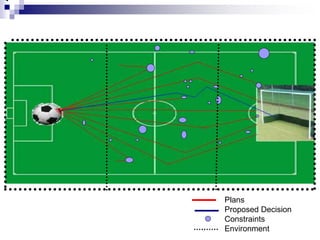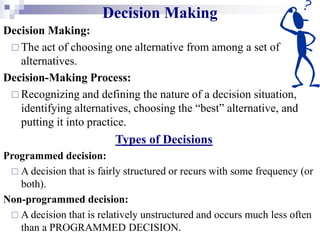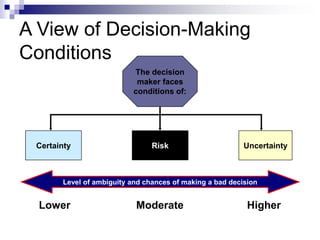02. Organizational Goals, Planning & Decision Making (2021).pptx
- 1. Organizational Goals, Planning & Decision Making References: ŌĆó Management (W. Griffin) ŌĆó Internet Chapter #3
- 2. Organizational Goals ’āś ŌĆ£Dream with a deadline," ’āś a goal is an observable and measurable end result to be achieved within a more or less fixed timeframe. ’ü« Goals are critical to organizational effectiveness and serve a number of purposes. a. Provide guidance and a unified direction for people in the organization. b. Have a strong affect on the quality of other aspects of planning. c. Serve as a source of motivation for employees of the organization. d. Provide an effective mechanism for evaluation and control of the organization.
- 3. Vision Vision statement answers the question: ŌĆ£What do we want to become?ŌĆØ Your vision statement is your inspiration, the framework for all your strategic planning.
- 4. ŌĆ£What is our business?ŌĆØ An enduring statement that distinguishes one organization from the similar enterprises. Declares the firmŌĆÖs reason for being ’ü« A mission statement answers three key questions: ’āś What do we do? ’āś For whom do we do it? ’āś What is the benefit? Mission Statements
- 5. ’ü▒ Centers for Disease Control ’āś Mission: To promote health and quality of life by preventing and controlling disease, injury, and disability ’āś Vision: Healthy People in a Healthy World ’ü▒ Pakistan Department of Health ’āś Mission: To protect, maintain and improve the health of all Pakistanis. ’āś Vision: Keeping All Pakistanis Healthy
- 6. Kinds of Goals 1. By Level a. Strategic goals- are goals set by and for top management of the organization that address broad, general issues. b. Tactical goals- are set by and for middle managers; their focus is on how to operationalize actions to achieve strategic goals. c. Operational goals -are set by and for lower-level managers to address issues associated with tactical goals. 2. By Area ’é© Goals set for the different functional areas of the organization. Eg. Marketing, Finance, HR etc 3. By Time Frame ’é© Goals may be set for long-term, intermediate-term, or short-term time frames. ’é© Short-term goals can be achieved within a year. Medium-term goals may take from a year to three years to achieve. Long-term goals require three or more years to achieve.
- 7. The planning function consists of: What is to be accomplished? How is it to be accomplished?
- 8. Barriers to Goal Setting and Planning ’ü«As part of managing the goal-setting and planning process, managers must understand the barriers that can disrupt them. Managers must also know how to overcome them. Major Barriers Inappropriate goals Improper reward system Dynamic and complex environment Reluctance to establish goals Resistance to change Overcoming the Barriers Understanding the purposes of goals and planning Communication and participation Consistency, revision, and updating Effective reward systems
- 10. Organizational Planning ’ü« Once organizations sets its goals then next stage is to decide how to achieve them Strategic Plans ’é© Are developed to achieve strategic goals. A general plan outlining resource allocation, priorities, and action steps to achieve strategic goals. Address issues related to competitive advantage and synergy. These plans are set by and for top management & have extended time horizon Tactical Plans ’é© A plan aimed at achieving the tactical goals, is developed to implement specific parts of a strategic plan, set by and for middle management & have somewhat moderate time horizon. These plans are concerned with getting things done.
- 11. Operational Plans ’ü▒ Plans that have a short-term focus. These plans are set by and for lower-level managers. They deal with a fairly small set of activities.
- 12. Time Frames for Planning 1. Long-range Plans ’é© cover present and future strategic issues; normally extend beyond five years in the future. 2. Intermediate Plans ’é© usually cover period from 1 to 5 years. They parallel tactical plans, are the principal focus of organizational planning efforts. 3. Short-range Plans ’é© have a time frame of one year or less. Covers managerŌĆÖs day to day activities. ’é© include action plans and reaction (contingency) plans. ’āś Action Plan- A plan used to execute any other kind of plan. ’āś Reaction Plan- A plan developed to react to an unforeseen circumstance.
- 13. Contingency Planning ’ü« Contingency is the determination of alternative courses of action to be taken if an intended plan is unexpectedly disrupted or rendered inappropriate. These plans help managers to cope with uncertainty and change. Ongoing planning process Action point 1 Action point 2 Action point 3 Action point 4 Develop plan, considering contingency events Implement plan and formally identify contingency events Specify indicators for the contingency events and develop contingency plans for each possible event Successfully complete plan or contingency plan Monitor contingency event indicators and implement contingency plan if necessary
- 14. Three Steps in Planning
- 15. StrategyŌĆ”! ’āś A strategy is a comprehensive plan of action designed to achieve a particular goal. The word strategy has military connotations, because it is derived from the Greek word for army. ’āś Strategic management is comprehensive and ongoing management process aimed at the conduct of drafting, implementing and evaluating cross-functional decisions that will enable an organization to achieve its objectives
- 16. ’ü« Strategic Management: A comprehensive and ongoing management process aimed at formulating and implementing effective strategies, a way of approaching business opportunities and challenges.
- 17. Strategy Formulation and Implementation ’ü«Strategy Formulation ’é©What the Plan is ’é©The set of processes involved in creating or determining the organizationŌĆÖs strategies; it focuses on the content of strategies. ’ü«Strategy Implementation ’é©How the strategy/plan is achieved ’é©The methods by which strategies are operationalized or executed within the organization; it focuses on the processes through which strategies are achieved.
- 18. Management by Objectives (MBO) ’ü« Management by Objectives (MBO) is a process of agreeing upon objectives within an organization so that management and employees agree to the objectives and understand what they are in the organization. ’ü« The term "management by objectives" was first popularized by Peter Drucker in his 1954 book 'The Practice of Management. ’ü« The essence of MBO is participative goal setting, choosing course of actions and decision making. An important part of the MBO is the measurement and the comparison of the employeeŌĆÖs actual performance with the standards set. Ideally, when employees themselves have been involved with the goal setting and the choosing the course of action to be followed by them, they are more likely to fulfill their responsibilities.
- 19. Using Goals to Implement Plans ’ü« A formal goal-setting process such as management by objectives (MBO) is an effective technique for integrating goal setting and planning by giving subordinates a voice and clarifying what they are expected to accomplish. Starting the formal goal-setting program Establishment of organiza- tional goals and plans Collaborative goal setting and planning Communicat- ing organiza- tional goals and plans Meeting Verifiable goals and clear plans Counseling Resources Periodic review Evaluation
- 20. ’ü« Management by Objectives Step 1. Set individual objectives and plans. Step 2. Give feedback and evaluate performance. Step 3. Reward according to performance. ’ü« Causes of MBO Failure ’é© Lack of top management commitment and follow-up on MBO. ’é© EmployeesŌĆÖ negative beliefs about managementŌĆÖs sincerity in its efforts to include them in the decision-making process.
- 21. The Basic Planning/Control Cycle
- 23. Decision Making Decision Making: ’é© The act of choosing one alternative from among a set of alternatives. Decision-Making Process: ’é© Recognizing and defining the nature of a decision situation, identifying alternatives, choosing the ŌĆ£bestŌĆØ alternative, and putting it into practice. Types of Decisions Programmed decision: ’é© A decision that is fairly structured or recurs with some frequency (or both). Non-programmed decision: ’é© A decision that is relatively unstructured and occurs much less often than a PROGRAMMED DECISION.
- 24. A View of Decision-Making Conditions Certainty Risk Uncertainty Level of ambiguity and chances of making a bad decision Lower Moderate Higher The decision maker faces conditions of:
- 25. Decision Making Styles ’āś Autocratic- Centralized authority, unilateral decisions without input from employees, power is with chair only. ’āś Democratic style- delegated authority, participative decisions. ’āś Laissez-faire style- complete freedom to employees to make decision and complete work in whatever way it fits. ’āś Consensus- Every one has to agree. Either convince or get convinced. ’āś Contingency style- policies are made with provision to change according to situation.
